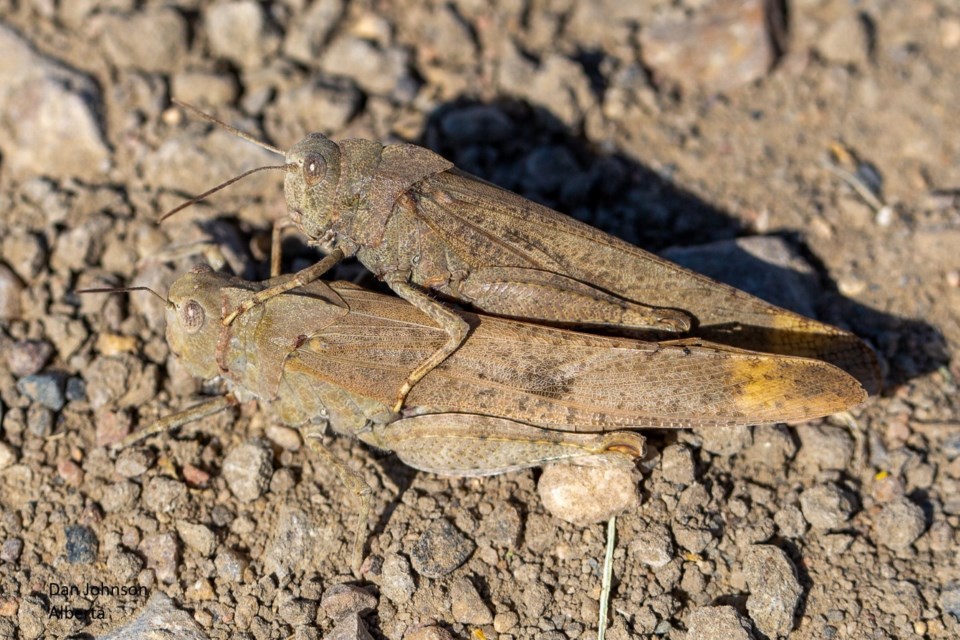With just over 80 species in Saskatchewan and occurring in vast numbers in some years, it’s not surprising that, in the opinion of many readers, grasshoppers would rank first in a list of ‘worst insects’ (followed closely, of course, by mosquitoes!). So, what is it that gives them this reputation and do they have any ‘saving graces’ that may warrant their forgiveness?
Well, first off, this reputation is engendered by the activity of just a handful of pest species, notably, the lesser migratory grasshopper, the clear-winged, and the two-striped. Under suitable conditions (see below), populations of these species can become huge, causing massive damage not only to crops but to vegetables under cultivation in gardens. Indeed, when wheat was essentially the only agricultural crop under cultivation, the lesser migratory grasshopper had a reputation as the major insect pest of the Canadian Prairies. However, since crop diversification, its ranking has been challenged by contenders such as wheat midge and especially crucifer flea beetles.
Like those of other insects, the life cycle of grasshoppers is strongly influenced by weather conditions. All but one or two prairie species have but a single generation per year and lay their eggs in late summer. If available, females select south- or west-facing slopes including ditches as these tend to become snow-free and warm up more quickly in the spring. The eggs, which may or may not begin embryonic development in the fall, are in the overwintering stage, capable of surviving the bitterly cold prairie winter (though a good coating of snow certainly helps to insulate them from temperature extremes). Eggs hatch in late spring, juveniles grow quickly through summer, and the adults mate and lay their eggs in the soil while ever-warm weather continues. Depending on the species, a female might lay 20-25 eggs in a frothy mass (an egg pod), and produce up to 10 of these during her quite short life.
So, one may ask, how can grasshoppers sometimes appear in such massive numbers while at other times they are barely noticeable? And it is here that weather plays a major role. A warm, dry spring accelerates embryonic development, hatching, and growth of young grasshoppers, leading to a larger proportion of the population surviving to become adults. Simultaneously, the lack of moisture retards plant growth and that which does occur is rapidly gobbled up by the developing ‘hoppers’. When warm, dry springs occur for several consecutive years, grasshopper populations can build up massively and ravage seedling crops. Conversely, cool, wet spring conditions are great for plants while slowing down grasshopper growth (and, incidentally, facilitating the spread of insect diseases which can have a large impact on grasshopper numbers). Thus, (crop) plant development outstrips grasshopper growth, and the insects seldom reach noticeable densities.
On the flip side of the coin, what are grasshoppers’ ‘saving graces’? Their primary value is that they are a major (even primary) food source for many native birds and other vertebrates, as well as for some predatory and parasitic insects. This is especially so for birds in the breeding season and when they are building up food reserves before their fall migration.
As well, several species are quite attractive in their colouration and habits. For example, the Carolina grasshopper, perhaps our largest species with females having a wing span reaching 10 cm, is quite common though often missed due to its excellent camouflage, matching the bare ground on which it prefers to sit. However, in flight, the insect is strikingly conspicuous, especially the males as they flitter and hover in the air while attempting to attract females. To the untrained eye, they can easily be mistaken for mourning cloak butterflies.
In most years, grasshoppers will not be a significant pest in the vegetable garden: for one thing, by the time the insects are at their hungriest (the ‘teenage’ juveniles and breeding adults), garden plants will be essentially fully grown; and secondly, as their name indicates, most grasshopper species prefer to eat members of the grass family, not the broad-leaved plants that constitute the majority of our garden crops. Only in a rare ‘plague’ year might it become necessary to consider applying some form of control.
Cedric Gillott is a retired entomologist and professor emeritus in the Department of Biology at the University of Saskatchewan.
— This column is provided courtesy of the Saskatchewan Perennial Society (SPS; [email protected] ). Check our website (www.saskperennial.ca) or Facebook page (www.facebook.com/saskperennial) for a list of upcoming gardening events




